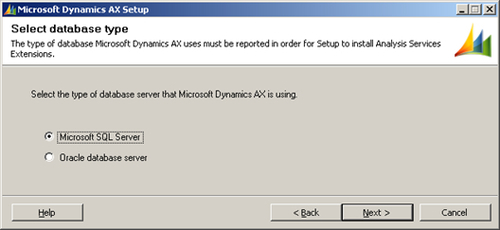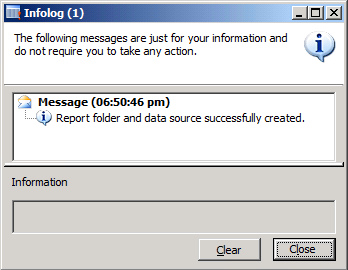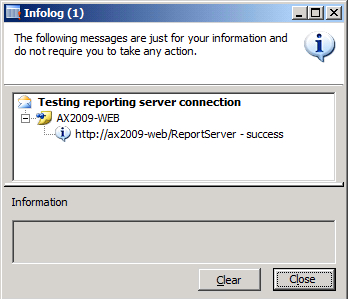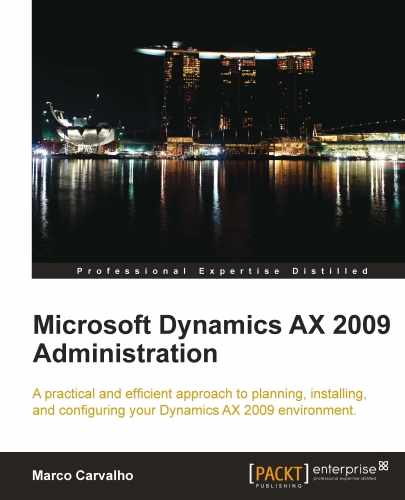In the previous chapter, we covered the implementation of the Enterprise Portal, which provided a limited web client interface access to Dynamics AX. Dynamics AX comes with a new feature called Role Centers, which goes hand-in-hand with the Enterprise Portal. Role Centers build on top of the Enterprise Portal to provide business intelligence and advanced reporting from the data in Dynamics AX. It is a new and powerful addition to the Dynamics AX component arsenal that will evolve as proceeding versions are released.
Role Centers are essentially dashboards that provide an overview of information to an end user. They are just SharePoint web pages with web parts. This implies that you can customize Role Centers like any other SharePoint page. For example, you can add a SQL Server Reporting Services report or an Exchange calendar to a Role Center. You can even modify the structure of how the web parts are displayed if you so desire. For more information on customizing SharePoint web pages, consult the following website: http://office.microsoft.com/en-us/sharepoint-server-help/CH010178298.aspx.
Dynamics AX comes with approximately 31 Role Centers. These Role Centers represent many business functions or roles. For example, a specific role could be a CEO, CFO, controller, or even a warehouse manager. At the heart of Role Centers is not only the Application Object Server (AOS) but also SQL Server Analysis Services and SQL Server Reporting Services that work in unison to generate a relevant representation of business data for analysis. Afterwards, all the data is organized into a SharePoint page for representation in the Enterprise Portal, which is also the default view when a user logs into Dynamics AX using the client or Enterprise Portal. From there, the user can quickly see the information that matters.
In this chapter, we will cover the following:
Installation and setup of Role Centers
Installation and setup of Analysis extensions
Installation and setup of Reporting extensions
Dynamics AX SQL Server Reporting Services setup
Assigning Role Centers
The earlier mentioned list contains a number of components that when setup, all work in unison to provide Business Intelligence Role Center functionality. However, you can still have limited Role Center functionality if Reporting extensions or Analysis extensions are not set up. Depending on your setup, the Business Intelligence setup of Role Centers may require some specific modifications in configuration and setup such as Kerberos authentication as covered in Chapter 5, Setting Up Kerberos Authentication.
Before we begin installing and setting up Role Centers, you will need to have at least local administrator privileges on the machines that you are installing the Role Center components on. You may also be required to change network and domain controller settings; in that case you will need to have network administrator privileges. You will also need the Dynamics AX DVD. Be aware that Role Centers require report deployment, installation of the Dynamics AX analysis database, and a functional Enterprise Portal. The following server components are required to install and set up Role Centers:
Web server
Reporting server
SQL Server Reporting Services 2008 or 2008 R2
Analysis server
SQL Server Analysis Services 2008 or 2008 R2
Note
In some infrastructure scenarios, it is plausible to have the reporting server and web server combined into one server. Similarly, the analysis server and database server can also be combined into one server.
Your network infrastructure setup will determine where each component of the Role Centers will be installed. For example, the Enterprise Portal will be installed on the web server since that is where SharePoint and thus IIS is installed.
To help determine where each component will be installed, refer to the topology diagrams found in Chapter 1, System Planning and Hardware Sizing. You may notice in Chapter 3, Setup and Configuration of the Enterprise Portal, when installing the Enterprise Portal, you inadvertently installed the Role Centers as well, since the install option for both the Enterprise Portal and Role Centers are combined. However, even though the web page content files for Role Centers were installed, the Reporting and Analysis extensions for Business Intelligence in the Role Centers were not installed. The following sections will cover the installation of the Analysis and Reporting extensions as well as the steps to configure each component to work properly in order to have fully functional Role Centers for Dynamics AX.
Analysis extensions are part of the Dynamics AX Business Intelligence framework. They are a set of predefined cubes (also known as default cubes) for SQL Server Analysis Services. Partnered with Reporting extensions and Role Centers, Analysis extensions complete the Business Intelligence capabilities of Dynamics AX. To install the Analysis extensions, you will need to be on the server in which you have SQL Server Analysis extensions installed. The Dynamics AX installation wizard will automatically install the Dynamics AX analysis database in the specified analysis server environment as depicted in the following steps:
Note
Unfortunately, due to limitations with the Dynamics AX installation wizard, it can only install Analysis extensions on SQL Server Analysis Services 2005. Fortunately, there are two ways to circumvent this. You can either install Analysis extensions on SQL Server Analysis Services 2005 and then upgrade to SQL Server Analysis Server 2008 or copy the Analysis extensions database to SQL Server Analysis Server 2008. To install Analysis extensions on SQL Server Analysis Services 2008, refer to How to install Analysis extensions on SQL Server Analysis Services 2008 in the Appendix.
Run the Microsoft Dynamics AX Setup wizard to add new components. In the Add or modify components screen of the wizard, mark Analysis extensions, as shown in the following screenshot and then click on Next

In the following screen of the wizard, select Microsoft SQL Server as the database server then click on the Next button:

In the next section of the wizard, Analysis extensions: Select an Analysis Services instance, you will be asked to select the Analysis Server instance in which you want the Dynamics AX analysis database to be installed in. The wizard will install to the default analysis server instance. After you have the appropriate analysis server instance selected, click on Next.

In the following screen you will be prompted to complete the installation of the Analysis extensions. Click on the Install button to finalize the installation, as shown in the following screenshot:

Once the installation of the Analysis extensions has completed, you will be prompted with the final screen of the wizard where you can confirm if the installation was successful or not, as shown in the following screenshot. When you are satisfied with the component’s installation, click on the Finish button to complete and close the wizard.

Reporting extensions is a utility that deploys a collection of Microsoft SQL Server Reporting Services (SSRS) reports. To install the Reporting extensions, you will need to be on the server in which you want to serve the SQL Server Reports. Make sure you can navigate to the SSRS report manager URL as well as the SSRS report server web service URL. After the Dynamics AX installation wizard installs the Dynamics AX Reporting extensions, you will manually have to run the Reporting extensions utility to deploy the reports. To install the Reporting extensions, perform the following steps:
Note
The Dynamics AX installation wizard cannot install Reporting extensions on SQL Server Reporting Services 2008 without a hotfix. For more information on obtaining and installing this hotfix, refer to Knowledge Base article 957312 or go to: https://mbs.microsoft.com/knowledgebase/KBDisplay.aspx?scid=kb;en-us;957312.
Run the Microsoft Dynamics AX Setup wizard to add new components. In the Add or modify components screen of the wizard, mark Reporting extensions, as shown in the following screenshot and then click on the Next button:

In the next section of the wizard, .NET Business Connector proxy account information, you will be prompted to enter the password for the Business Connector Proxy account, as shown in the following screenshot. This is necessary because once the Reporting extensions are installed, the Reporting extensions utility will need to access the specific AOS to which the reports will be associated to. After you have provided the appropriate password, click on the Next button to proceed to the next step.

In the following section of the wizard, Reporting extensions: Select a Reporting Services instance, you will be prompted to select the appropriate SSRS instance, as shown in the following screenshot. Make sure you also mark the Configure IIS and Report Server checkbox so the installation wizard can automatically modify the SSRS configuration files and other settings in IIS that belong to the Report Server and Reports Manager website to appropriately integrate with Dynamics AX. Once the appropriate SSRS instance is selected, click on the Next button to proceed.

The next section of the wizard is basically a confirmation to install the Reporting extensions based on the settings provided in the previous sections. Make sure the Restart IIS after installation is completed checkbox is marked, as shown in the following screenshot. When you are confident with your settings, click the Install button to start the installation process.

Once the installation process completes, you can determine if the SSRS and IIS were appropriately configured or not, as shown in the following screenshot. If the box next to the Reporting extensions label is not green, then you must open the log file to determine what went wrong. If the installation was successful, you can automatically run the Reports Deployment utility that was just installed to begin deploying the Dynamics AX SSRS reports. Otherwise, unmark the Automatically launch Reports Deployment utility, if you desire to do this at a later stage.

The previous steps outlined the process of installing Reporting extensions. This is indeed a straightforward process for installing in a single environment. However, while the database and Analysis extensions can be installed for multiple Dynamics AX 2009 environments, unfortunately, Reporting extensions cannot. Reporting extensions can only point to a single Dynamics AX environment on the server it is hosted on. Whatever the Business Connector Configuration Target is pointed to in the Microsoft Dynamics AX 2009 Configuration Utility in Windows’ Administrative Tools, is the environment that Reporting Extensions will function with.
After you have installed the Reporting extensions as we did in the previous section, you will need to run the Reports Deployment utility. If the utility did not automatically run after the installation, you can manually run it by going to Start | All Programs | Microsoft Dynamics AX 2009 | Microsoft Dynamics AX 2009 Reports Deployment. The Reporting Deployment utility will deploy reports for the Dynamics AX AOS that is specified in the Business Connector Configuration Target, in the Microsoft Dynamics 2009 Configuration Utility. Once you have the Reports Deployment utility running, perform the following steps to successfully deploy the Dynamics AX SSRS reports:
Note
In order for the Reports Deployment utility to run properly, ensure that Dynamics AX 2009 SP1, Visual Studio 2008 shell, and Windows Server 2008 SDK are installed.
Upon loading the Reports Deployment utility, it will automatically generate a list of report libraries from Dynamics AX that you can selectively deploy, as shown in the following screenshot. Typically, you will want to mark <Select All> to deploy all the available reports to your SSRS server. Once you have selected the appropriate report libraries, click on the Next button to begin extracting the libraries.

Once the libraries have been extracted, the utility will automatically begin building the report libraries and preparing them for deployment. The number of reports you selected will determine how long this process takes. If you have selected all report libraries, this process can take about half an hour to complete. Once these initial processes are completed, you will be prompted to modify the SSRS connection string for the reports, as shown in the following screenshot. Depending on your server setup, you may need to modify the Data Source property setting to connect to the appropriate Dynamics AX 2009 database. Once you are satisfied with the connection string(s), click on the Next button to proceed to deploy the reports.

The following process is the actual report deployment process. This process can take more than one hour to run depending on how many reports you are deploying. Once the deploying completes, you will be prompted with a message log and a location of the deployment log file for review, in case there were any errors or warnings, as shown in the following screenshot. To complete and exit the utility, click on the Finish button.

Once the deployment of Reporting extensions is successful, you should confirm that the reports have indeed deployed to the reporting services website. Simply navigate to your SQL Server Reporting Services (SSRS) Report Manager site with Internet Explorer, as shown in the following screenshot. Verify that the Dynamics folder is created and that the reports are deployed to it. You will see a similar screen depending on the number of reports that were deployed.

Even though the installation wizard and the report deployment utility perform many automated tasks, there is still some manual setup that needs to be performed within Dynamics AX. We will need to notify Dynamics AX where the reporting server is and set various configuration settings. The following steps explain the process:
Run the Dynamics AX client. Once Dynamics AX loads, go to the Administration | Setup | Business Analysis | Reporting Services section. Click on the Reporting Servers link. The Reporting Servers form will load. Notice that the SSRS server information is already provided. This was automatically created during the installation of the Reporting extensions. If there is no information provided yet, there is a valid reporting server to use, simply create a new record and provide the information.

If specifying a new SSRS server, go to the General tab and begin entering the appropriate information for your current SSRS setup.

After you have filled out the appropriate fields in the General tab, click on the Advanced tab and enter the appropriate information.

In SQL Server 2008 or 2008 R2 Reporting Services, the installation wizard for Reporting extensions may have not created the Dynamics AX data source even though it is specified. To create it, ensure that DynamicsAX is specified in the Data source name textbox and click on the Create button to automatically create the data source in the report server. An Infolog window will pop up determining whether the process was successful or not.

Once you have specified all the appropriate information, click on the Validate button to verify that Dynamics AX can access the reporting server and that all the reporting settings are properly set. If so, you will receive an Infolog message, as shown in the following screenshot:

Now that Analysis extensions and Reporting extensions are installed and configured, we can proceed to assign users to actual Role Centers. Within Dynamics AX, Role Centers are also referred to as User profiles. In fact, the form to assign Role Centers is in the User profiles form. To assign and understand the various options for assigning users to Role Centers, follow the steps outlined here:
To assign a Role Center to users, load the User profile form located in Administration | Setup | User profiles.

Let’s assign several users to the Accountant profile. To do this, select the Accountant profile and click on the Bulk Add Users button.

Select which users to assign to the Accountant profile. If the users are already organized in a Dynamics AX group (for example, an Accountant group), select the group in the Filter by Group drop-down to easily filter by user group. There is also an option to specify which company the profile will be active on. This is present because one user can have different profiles in separate companies. For example, a user can have an Accountant profile in company CEU while having an AccountingManager profile in company CEE. When the appropriate users are marked, click on the OK button to add the marked users to the Accountant profile.
Additionally, users can be assigned to profiles in the Active Directory Import Wizard, as shown in the following screenshot. This process is similar to the previously mentioned steps.

Since the selected users were mapped to a profile, they will now be associated to a Role Center. Individual users can be added one at a time by clicking on the Add user button, as shown in step 1. User profiles can also be saved to be exported and imported between Dynamics AX environments to simplify the process of creating duplicate user profile settings.
This chapter focused on the process of setting up the Enterprise Portal with Role Centers, SQL Reporting Services, SSRS, with Dynamics AX. Reporting extensions are a vital component for the Business Analysis features that Dynamics AX 2009 provides. Most reports query Dynamics AX directly while some query SQL Server Analysis Services cubes. Installing Reporting extension along with Analysis extensions are necessary in your arsenal for setting up Role Centers.
In order for users to be able to access and use the reports, permissions must be set up. In Chapter 9, Security and User Administration we will cover how to appropriate setup permissions on reports.
In the next chapter, we will cover the process of setting up Kerberos authentication. The setup and configuration of Kerberos authentication is required for Role Centers to function properly when each Dynamics AX server component is implemented across multiple servers. Otherwise, if Kerberos authentication is not appropriately set up, the Role Center web parts will fail to load properly.
